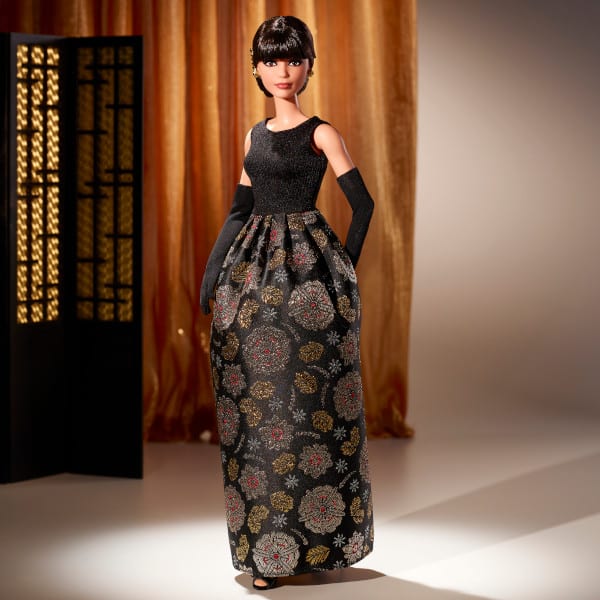View this post on Instagram
There are few toys—and few fictional characters—as iconic as Barbie. To some, her plastic blonde locks and impossibly cinched waist are symbols of all the wrong messages society sends to young girls. To others, Barbie is an outlet for creativity—in fashion, careers, and role-playing the social scenarios of families and friends that children notice all around them. To the rest of the world, Barbie defies categorization—encompassing the good and the bad.
This might seem like an excessive amount of importance placed on a children's toy; but, in the over 50 years of her reign, Barbie has proven to be a near-constant cultural touchstone. The history of America's most iconic doll is embedded in American culture and the larger changes that have shaped the past half-century—including feminism, the civil rights movement, and evolving conceptions of gender. From her swimsuit debut in 1959 to the Balmain ready-to-wear collaboration of 2022, Barbie remains relevant.
Today, Barbie is no longer just for girls. She is more diverse, and so is Ken. The dolls now come in a variety of body shapes, skin tones, and hairstyles. Mattel—the legendary toy company who makes Barbie—has invested in a more diverse future in the hopes that Barbie can shed her white, able-bodied, ultra-thin image that many have pointed to as damaging. Barbie and her friends are championing more diversity and inclusion, mirroring the reality of modern society.
Who is Barbie?
In the 1950s, inventor Ruth Handler watched her daughter play with paper dolls. At the time, young girls were encouraged to develop their nurturing instincts with baby dolls. However, Handler noticed that her daughter and her friends were more interested in re-enacting the social scenes of teens and adults. Studies have since confirmed that children use dolls to role-play social interactions they see around them, thereby developing empathy and social skills.
Handler's husband Elliot Handler had—coincidentally—started a toy company known as Mattel, Inc. in the mid-1940s. In 1955, Mattel had won the Mickey Mouse Club contract, a major entry into the world of popular toys. The company's next big break came at the American International Toy Fair in New York City on March 9, 1959. The couple presented a thin plastic doll, referred to as a teenage fashion model. In a sophisticated striped swimsuit, the doll came in blonde and brunette. Her high ponytail anticipated the swinging sixties. Her eyes glanced demurely aside. Her name was Barbie, after the Handler's daughter Barbara.
Some toy critics and focus-group members were skeptical. The new doll seemed more racy than the traditional baby dolls. Her full bust and minute waist defied natural proportions—in fact, the doll was based on the German Lilli doll, who was meant as a sexy gag gift for adults. True to her role as a model, Barbie could be outfitted in all the latest fashions (sold separately). Mattel sold the sleek doll with television ads, a pioneering new way to market to child consumers which they developed for the Mickey Mouse Club. In the first year of production, Barbie sold over 300,000 units.
A Fashion Icon
From her earliest incarnation, Barbie has been the penultimate fashionista. Her original black-and-white swimsuit has seen been supplemented by thousands of outfits. Mattel's designers haunted Parisian runways, taking inspiration from the legendary mid-century designs of Christian Dior and Yves Saint Laurent. Over 50 “life-size” fashion designers have created looks for her—including Versace, Calvin Klein, and Burberry.
Barbie's outfits changed with the times. In the 1960s, the grace of Jacqueline Kennedy gave a touch of sophistication to the doll's wardrobe. In the 1980s, Jane Fonda and neon sweatbands were the mode. As fashions morphed, so did Barbie's stylish makeup. Her cat eyes and pursed rosebud lips transitioned into a smile in 1977. Her face shape also shifted over the decades to be a slightly more “realistic” shape.
While Barbie is known—and justifiably critiqued—for her unrealistic body proportions, her iconic pointed feet are a memorable part of childhood for many. Too small for her body, the tiny toes provide no real measure of balance for Barbie's lanky frame. While the Lilli doll had painted-on heels, Barbie's feet are bare. Children could collect tiny plastic shoes to slide onto her feet, marginally improving her shoddy balance. From glitter slides to sky-high strappy heels, the doll had a shoe for any occasion except athletics. Christian Louboutin even crafted shoes for the iconic doll. However, Mattel did eventually develop “sporty” dolls with flat feet and hinged limbs, including a 1998 tribute to soccer player Mia Hamm.
Built Like a Barbie
View this post on Instagram
Barbie's body has inspired decades of debate. Impossibly slender and busty from the beginning, her figure has changed with the times. Her original waist was adapted to rotating but maintained shocking proportions. Then around 1997, Barbie at last acquired a belly button. Her swivel waist was phased out in favor of a sculpted plastic torso. Her breasts shrank somewhat and her waist widened to a more natural shape. However, Barbie remained unrealistic. Her proportions on a real human would be roughly 5'9″ tall, with a 39″ bust, an 18″ waist, 33″ hips, and a size 3 shoe.
Many have alleged that this extremely unrealistic figure has been detrimental to the body images of decades of young women. In 1965, a slumber party-themed Barbie was sold with a pink scale reading 110 lbs and a diet manual telling her not to eat. Despite the less explicit messaging of some later models, the Barbie-effect has long troubled parents and psychologists. One rigorous study in 2006 discovered that exposure to the dolls led to greater anxiety about being thin in young girls. Similar concerns has been voiced—predominantly by mothers and the burgeoning feminist movement—almost since the doll's debut.
Despite the blossoming of the Barbie brand in the internet age, modern sensibilities seem to have turned on the ultra-thin doll. In response to declining sales in recent years, Mattel undertook a super-secret mission to revolutionize the world's most infamous body. Finding through focus groups that mothers were enthusiastic about curvier, more realistic figures, Mattel also approached the harshest critics—children. Some kids mocked the larger dolls, but modern little ones have felt the impact of cultural shifts. Mattel noted that the kids were reluctant to mock the dolls to adults, and that hair color seemed to be more important than weight in choosing their favorite.
Mattel's secret project was revealed in 2016 with the launch of Fashionistas, a line which included petite, curvy, and tall dolls in addition to the traditional build. The gamble of changing one of the most recognizable toys in the world was not lost on Mattel. Kim Culmone, head of design, told Eliana Dockterman of TIME, “It’s a personal issue because almost every woman has owned a Barbie, and every woman has some relationship with or opinion about Barbie.” Those relationships can be complex and deeply personal, but Mattel decided Barbie needed to modernize to be the feminist, inclusive role model they want her to be.
Romance and Role Models
View this post on Instagram
Barbie's boyfriend Ken Carson was introduced in 1961. Blonde like his lady friend, Ken's physique has also changed over the years. He evolved from a slender build to a buff body. The character's backstory is set in Willows, Wisconsin, a fictional town from which Barbie also hails. Throughout their storied history together, Ken served as Barbie's arm candy. Throughout her career as a movie star, astronaut, and presidential candidate (among dozens of other professions), Ken has been billed as Barbie's number-one fan.
While it always has been Barbie's world, Mattel had recently expanded Ken's world, backstory, and diverse appearances. It can safely be said that children of all genders have long enjoyed playing with dolls, but shifting norms and the abolition of gendered toy aisles at last acknowledge that dolls and make-believe are fun for everyone. Like Barbie, Ken has acquired new body types to reflect: slim and broad. He is now available in a diverse range of hairstyles and skin tones, with stylish clothes for any taste.
Both Barbie and Ken have held many careers. While Barbie's relationship to feminism is nuanced, she certainly pursued careers which were rare for women at the time. In 1968, Barbie was an astronaut—one year before the moon landing and five years after the first woman went to space (the second was not until 1980). In 1973, Barbie was a surgeon at a time when only 9% of doctors were women. In 1985, she became a CEO too, with big hair and a pink power suit. At times these representations have been flawed—computer engineer Barbie had to be saved by her male colleagues because she bumbled the project. However, in the minds of many young women, these occupations opened an opportunity for imagining their own possibilities.
View this post on Instagram
The diverse offerings now presented by Mattel are a great step towards inclusive toys. However, Barbie's relationship to race is a complex one. In 1968, Mattel introduced Barbie's friend Christie, a stylish young Black woman with an afro hairstyle. She was joined by her boyfriend Brad, the first Black male doll of the Barbie universe. Dolls of color were, however, relegated to the supporting cast of the doll world until 1980. In that year, Mattel released the first African American and Latina Barbie dolls, who were the central named characters in their own right.
Barbie has long been criticized as promoting Eurocentric beauty standards. For many years, Barbies of color were created using the same mold as the caucasian dolls. Mattel's eventual adaptations of facial features and hairstyles have also been criticized for too easily falling into stereotypes about Black women. Representation in children's toys is critical, but undoing the work of a culture of white supremacy can be hard. Scientists using dolls found African American children in the 1940s preferred white dolls; more recent research has found this preference for lighter skinned dolls persists.
While this cannot be laid at the foot of Mattel, there is a strong argument that the toy industry has played a role in shaping how young children see themselves and relate to the concept of race. Despite the much more diverse range of Barbie dolls available today, editor Shanon Ashley noted on Medium that the white, blonde Barbie is still the norm in pre-packaged career play sets. The diverse Fashionistas line is cheaper and tends to come with fewer extra props. Black dolls—or dolls of color in general—are still presented as alternative and often harder to find. As Ashley asks, what does is it mean for Barbie's purported inspirational message if the slender, typically blonde, white heroine is still front and center?
Barbie's New Frontiers
View this post on Instagram
Mattel is attempting to revitalize Barbie in a world which is less entranced by the thin, white, blonde “ideal” of yesteryear. How can Barbie collaborate with high fashion designer Balmain to clothe ultra-thin models while selling a message of body positivity in toy aisles? How can Barbie—a doll played with by the grandparents of today's children—compete in a toy market inundated with endless more modern choices? It is estimated 92% of girls have owned the doll, but how does Barbie fit into a world of evolving gender norms?
Many of the answers to these questions are still uncertain, although Mattel has certainly tried to diversify their brand to appeal to millennial parents and their children. Like many of the concepts she represents, Barbie has survived over 60 years. Creativity, whimsical play, and a “girls can do” attitude offered by the toy still hold appeal. However, her Eurocentric, able-bodied, male-gaze centered beauty still complicates her legacy and the relationship between doll and child. The future of Barbie will likely be just as interesting as her past, continuing to reflect evolving notions of childhood, gender, and race.
View this post on Instagram
Related Articles:
Mattel Creates One-of-a-Kind Barbie Dolls Based on Female Heroes of the Pandemic
Mattel Unveils More Barbie Dolls to Celebrate the Diverse Beauty of Black Women
Barbie Introduces More Diverse Dolls to Show Beauty Comes in Many Forms
Doll Photographer Reimagines Barbie and Ken as Soviet Civilians Living in the USSR






















































































